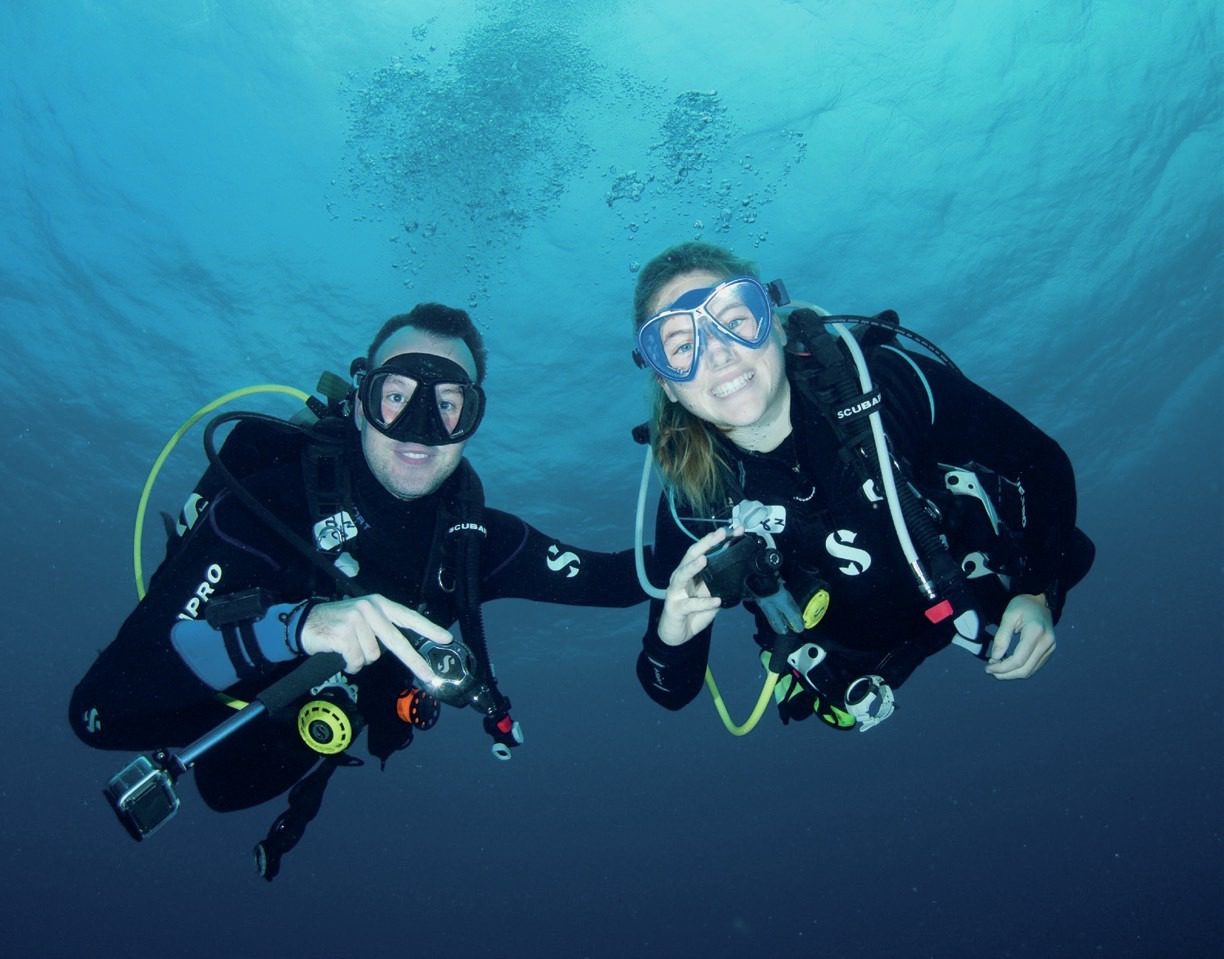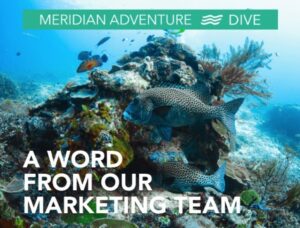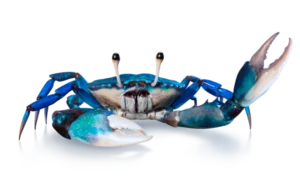We chat to Mark Wynne and Holly Wakely about their growing Youtube Channel, what they love about teaching people to dive, and why it is important to get more youngsters into the sport.
Photographs courtesy of Mark Wynne and Holly Wakely.
How did you first get into diving?
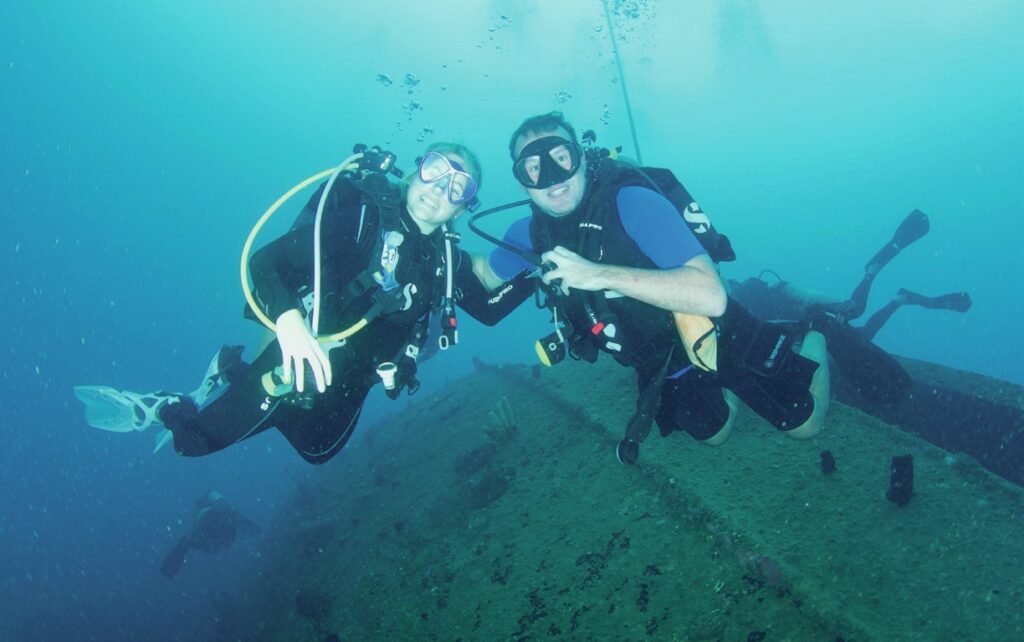
A (MW): As a youngster I always wanted to learn how to dive after watching Blue Planet, I know, super cliché. This seems to be the way most divers in the UK start, but I didn’t realize it was even an option when growing up in Scotland and the South of England. In 2006 our family took a trip to Fuerteventura, and after an unlikely banana boat incident, I was able to take my first breaths underwater.
During the trip, my wee sister Chloe decided to go on a banana boat the day before our Discover Scuba Dive experience. After asking for ‘just one more run’, she got a head injury and wasn’t allowed to dive the next day. The dive center suggested instead of a refund for Chloe’s experience, I should do the PADI Scuba Diver course. I did and fell in love with the sport, seeing angel sharks and rays everywhere.
A year later, not much progression had occurred in my diving career, due to that freezing Scottish water, until a trip to Bulgaria in the Black Sea. All excited to be diving again as a PADI Scuba Diver allowed to only 39ft with a professional, I learnt not to always just trust the dive centre or club you are diving with. Being naïve with only two dives, I was shocked to discover, when completing our logbooks, my third dive was penetrating a wreck at 104ft in the Black Sea.
I decided at that point it was time to reach out to dive centers in Scotland to learn to dive properly and get my Open Water certification, even if it is in the freezing winter in Scotland. The rest is history – after those few cold dives I was fully hooked.
A (HW): I’ve been breathing compressed air since I was four, but got certified in Cayman at 10. It was almost in my blood to dive, both my parents were divers prior to the arrival of my older brother and I. Anyone that has met my parents knows that there was no way children were getting in the way of their lifestyle and they would just have to fit us in somehow, hence how we got into Kids Sea Camp and diving.
From four to seven, I did the SASY program and from eight to ten, I climbed my way through the ranks of Seal and Master Seal Team. The love for diving stuck, and when given the option to go on a dive holiday or another holiday of some variety, I always chose to dive.
I suppose I have my parents to thank for throwing me right into the deep end of diving and they are how I originally got into it. The passion grew the older I got, and I started to look more and more forward to our summer and fall diving trips. It was always a treat being able to take the day off from gymnastics camp to go on a two-tank dive trip with my dad, being on the Dive Bermuda boat from the day I turned ten. Seven years later I am back on the same boat all summer, helping out and being a tank monkey – that was the best summer I could’ve asked for.
You have both dived in an enviable list of locations around the planet – what are some of your favorite destinations, and why?
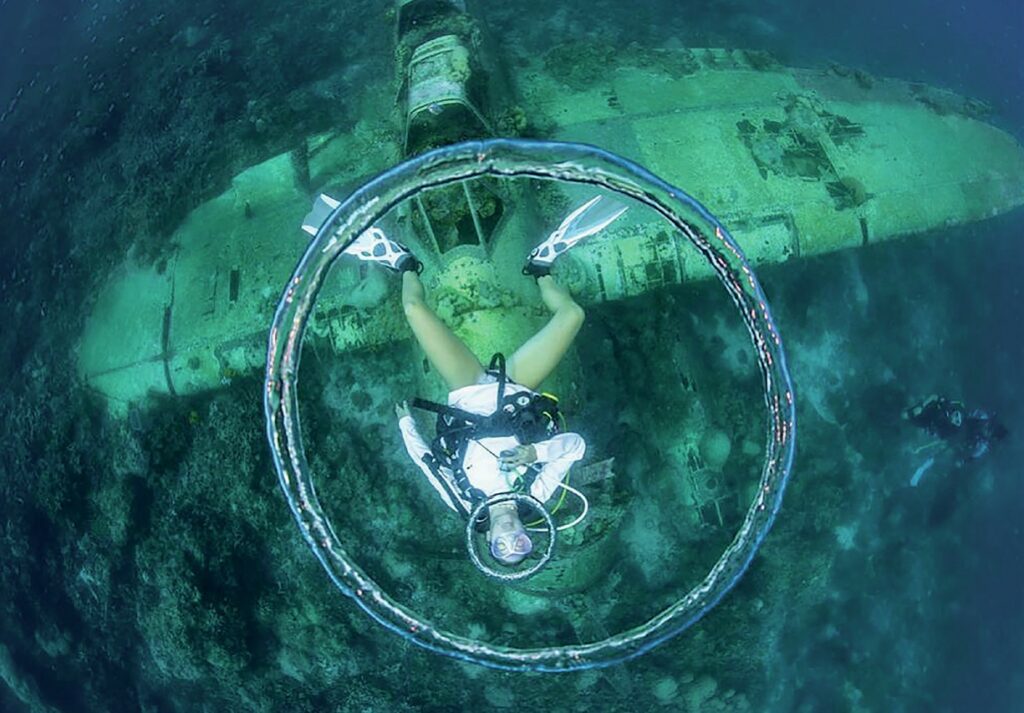
A (MW): I do love UK diving having spent the majority of my diving career all over the UK. But let’s be serious, we all want to escape those cold, dark and green dives for warmer locations. I have dived in over 30 countries and have had to think long and hard over this question. Why, you may ask? When you are diving around the world you get to experience amazing locations and different creatures resulting in each and every location having memorable and amazing experiences. Like the first whaleshark in the Red Sea, or exploring the cenotes in Mexico, even diving with sharks down in Australia.
If I have to choose, then it is between the Maldives or Mexico. Mexico has so much to offer; from diving the cenotes, to bull sharks in Playa Del Carmen and drift dives in Cozumel. There was so much to do. You look at our experience in the Maldives, sharks, sharks and even more sharks! It was unreal and incredible. Then there is Bermuda too, but I will leave that to Holly.
A (HW): Galapagos is hands down my favorite diving destination, the variety of marine life and conditions you’re able to dive in is mind blowing. I love liveaboards, they’re my favourite way to dive, and the Galapagos liveaboard was incredible. Up before dawn, seeing dolphins and whalesharks before breakfast then immediately kitting up for a fast current dive with hammerheads. It was seriously unbeatable. We did take a recent trip to the Maldives, which has closed the gap between my favorite destinations, with the Maldives liveaboard in a close second.
I will forever love the pelagic, larger life but do still have appreciation for macro life; little shrimps, crabs and nudibranchs. The Maldives can offer both types of diving and was a great well-rounded trip. I can’t forget Bermuda, which will always be one of my favorite places to dive, it’s home after all. The swim-throughs and arches are incredible to dive through and I know most of the wrecks like the back of my hand, I can’t go wrong diving here.
Mark, you are a PADI Course Director – what do you most enjoy about teaching people to dive, and in particular, how to become a diving professional?
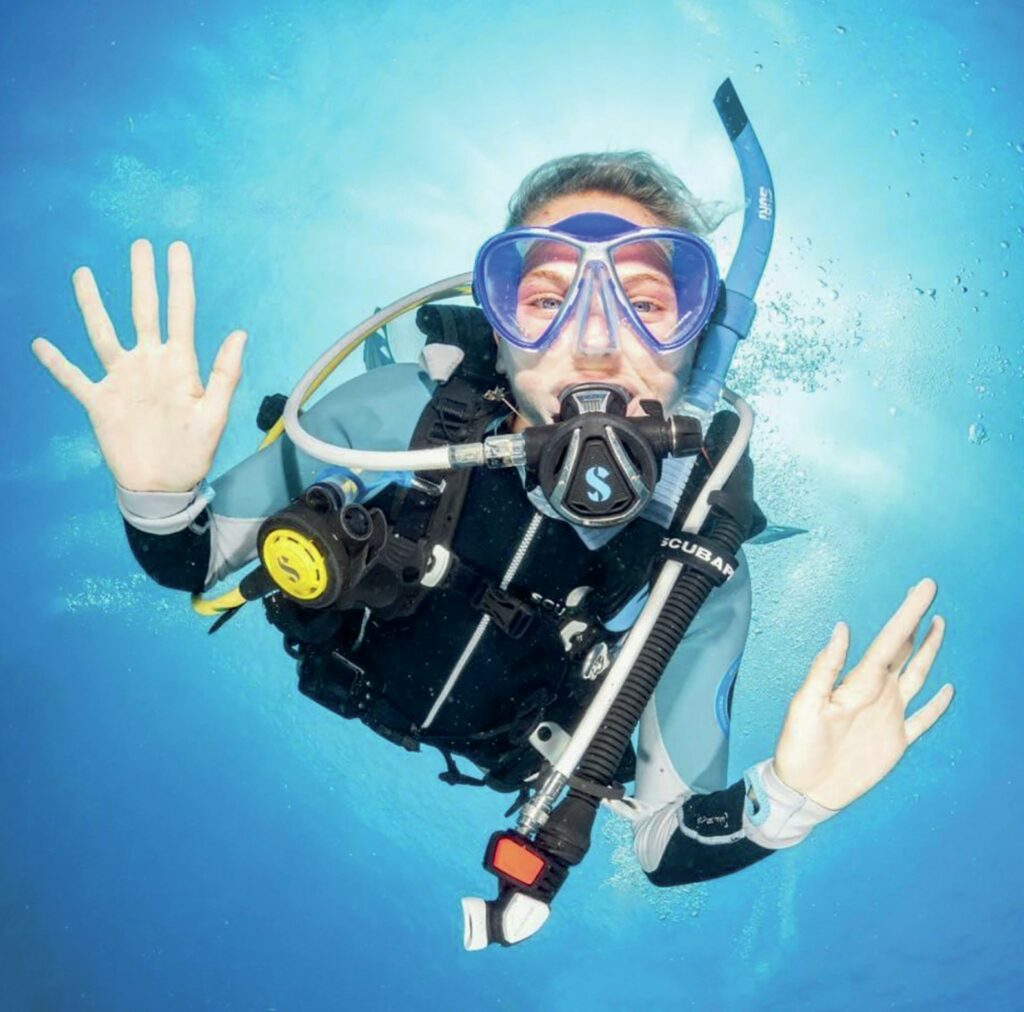
A (MW): I never intended to become a dive instructor when I first started diving. You always had that one or two friends who would suggest, let’s do our Divemaster together and so on. Before I knew it I was doing my Instructor Development Course in Glasgow and Instructor Exam in Newcastle. A few years later I started my IDC Staff Instructor course in Hull. Everyone else in the dive industry seems to have exotic locations like Thailand or Bonaire.
I have Glasgow, Newcastle and Hull. But I wouldn’t change it. Learning to dive and teach scuba diving in the cold UK waters prepares you better than anywhere else. Going from teaching open water courses in drysuits in three-foot visibility in a Scottish Sea Loch makes teaching in the crystal-clear waters of the Caribbean ridiculously easy in comparison.
I love teaching people to overcome their fears or to see their face light up when they get to experience the amazing underwater world for the first time. We have to remember diving is not for everyone, so never force or push someone to do something they do not want to do. But when you can see a student is nervous and excited, there is the great satisfaction you get when they explore the underwater world, their desire for more adventure and to protect the ocean.
Being able to share your passion for the ocean to others is incredible. After completing my PADI Course Director training in the Dominican Republic with PADI Worldwide in July 2021, I am now able to teach the next generation of instructors to do the same. Scuba diving, especially in the UK, has an aging demographic and being able to train more young instructors is exciting. It will keep our sport thriving and hopefully create more ocean advocates in the process. When looking for an Instructor Development Course to join, vet out the Course Director running the programme, as this makes a huge difference to your experience.
Holly, you were the world’s first PADI Junior Divemaster. Give us your take on this brand-new course, and why you think it is a great stepping stone for teenagers on their diving journey.
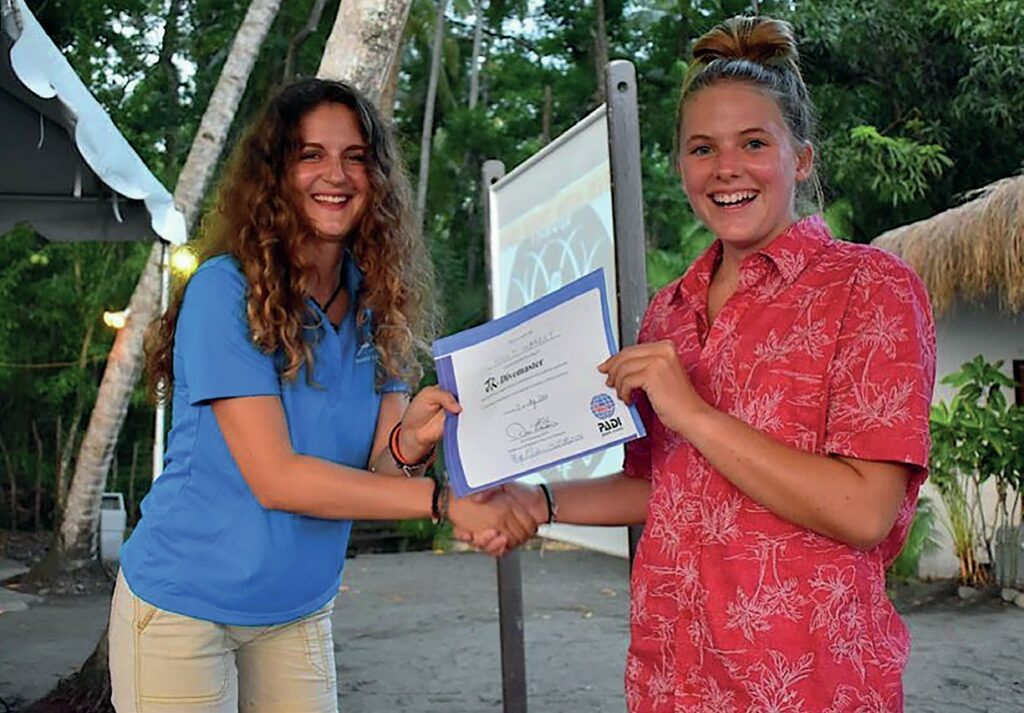
A (HW): Being the pilot diver for this program is something I am extremely grateful for and it was a really great step towards becoming a professional in the dive industry. Personally, the most valuable aspect of this course for me was that it put another step between Master Scuba Diver and Divemaster, which to me, seems like a pretty large leap.
I got the luxury of participating in the Junior Divemaster program in St Lucia, where I also later upgraded to the full Divemaster. Courses like this can take you all over the world, if you let them. Testing out this course for PADI was an incredible opportunity for me and is something I will never forget and will always look back on as an achievement.
I got to see the course outline when it first came out and test out each and every aspect, making sure it is doable for divers aged 15-18. When the course went live I was able to assist the instructor for the world’s second Junior Divemaster and see where pieces of the course outline had been changed or altered. The Junior Divemaster course is similar to the Divemaster course but takes away the liability features that require the candidate to be 18.
It teaches you how to set up a dive site and help manage divers in the water, making a more vigilant and well-rounded future professional. As a young diver, 18 can seem like a really long way away when you reach the Junior Master Scuba Diver rating at just 12 years old, so this new program gives something to look forward to and a goal to achieve, keeping the spark for diving there. This course is perfect for any young diver that is interested in becoming a future professional, or just furthering their diving knowledge.
Holly, you grew up diving with Kids Sea Camp, and now work for them on some of their family-friendly trips. Why do you think it is so important that we get more of the next generation into scuba diving?
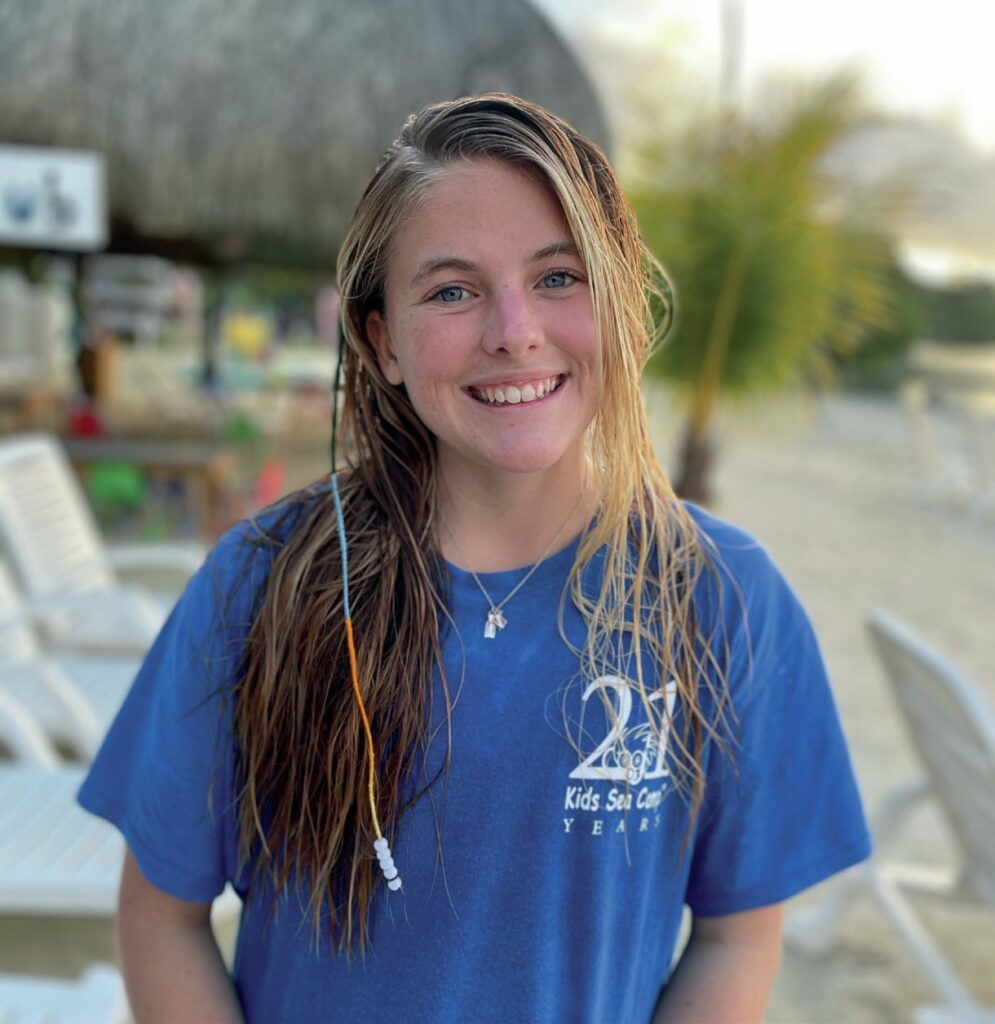
A (HW): One thing that is very interesting to me is some of the confused and concerned looks you get as a young diver, walking onto a dive boat as ten year old, setting up your own gear and listening to the brief, just like everyone else, but it’s not something you see often. The vast majority of divers tend to be older then 15, but I do think it is important that we get the next generation into diving more and more.
Younger people tend to bring new ideas to the plate and have a spark that comes with that, they are excited and enthusiastic about the ocean and want to help bring more people into the sport. In the younger generations, we have been brought up talking about what is happening to the world right now, the rising ocean levels and increased pollution for example. Sustainability and lowering your carbon footprint is a topic that is well known in the younger generations, who are noticeably putting an effort into changing their habits and bettering the world.
In diving this is really important because we put ourselves into the habitat of other animals, which are also being affected by our actions, as humans. We need to teach not to touch or take anything, and only leave our bubbles behind. Kids and teenagers are like sponges; they will absorb all this information and pass it on to their friends and others they are diving with. They will also pass messages through social media, which is huge in the younger generations.
Coming up with new ideas, and being able to discuss topics and exchange ideas is so easily done through social media. Which in turn can help grow the dive industry. We need younger people to start diving more, whether that is recreationally or professionally.
How did your globe-trotting YouTube Channel come into being?
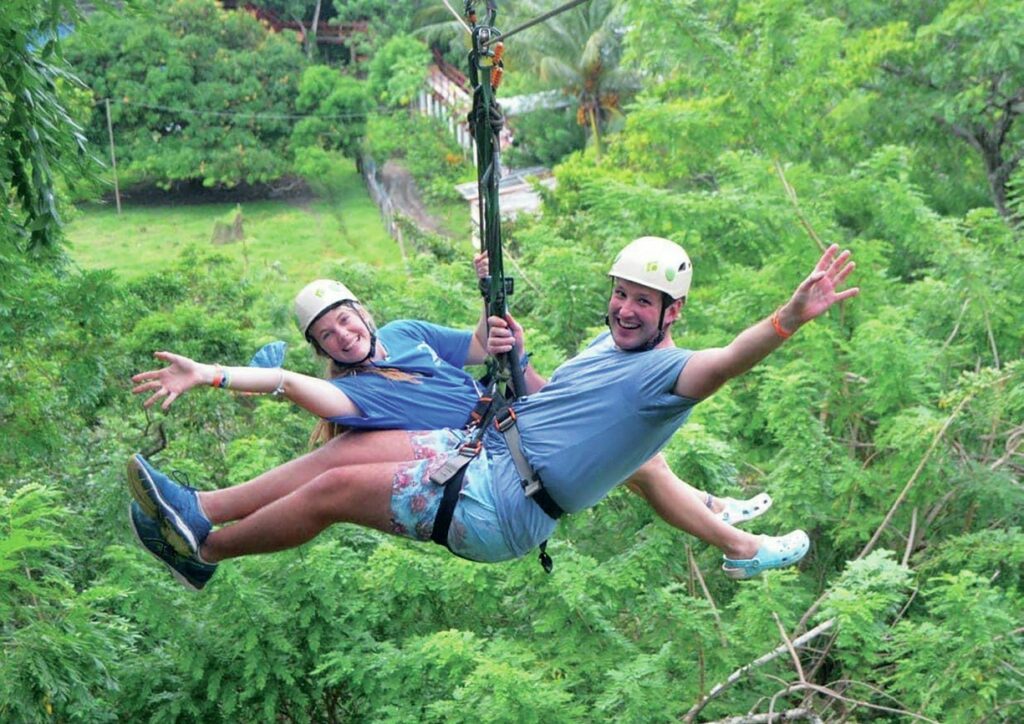
A (MW): Surprisingly, it never was the intention to turn out to be what it is today. After travelling for a year around the world in 2016, I was back in Glasgow wondering what to do next. I started Blue Horizon Diving (BHD) as a freelance dive school and partnered with Scubapro as an education partner. Only three to four months into the venture, BHD was really taking off but life through a curve ball at me.
Before I knew it I was on a plane to Bermuda to start working in the offshore finance sector on a three-year contract. I didn’t want the brand we were building to just disappear as I always intended to return back to Glasgow. When I arrived in Bermuda I also started working for Dive Bermuda on the weekends as an instructor. The owner of Dive Bermuda, Mark Diel, allowed me to carry my GoPro or Paralenz on dives I was guiding to film. I started to put clips together of the dive sites to put on YouTube.
Fast forward a few years and we are in lockdown. I was bored in Bermuda’s first lockdown watching different YouTube channels and noticing different travel vlog styles. I started searching scuba diving channels and didn’t really see a scuba diving travel channel. It made me think, is there a niche here for us scuba divers? I bumped into Teddy Gosling, of the famous Gosling’s Rum family at Horseshoe Bay Beach one afternoon. Teddy and I started talking and he recommended we needed to take our viewers on a journey from start to finish in vlog style episodes.
We do everything in our videos from film, produce, edit and try to promote at all our own expenses and costs. But we are okay with that as the YouTube channel is fun for us and allows us to meet and speak to amazing people from all over the world. Plus we get to share our love for the ocean to thousands around the world. When Holly joined the channel the adventure became exciting and added a new dimension, which I can’t thank her enough for. Holly has been unreal and I’m lucky to have her next to me on this adventure.
A (HW): This is something I became a part of by chance, appearing in one of the videos in the middle of last year. It turned out to be a lot of fun being part of the videos and I slowly became a permanent part of the channel. As an instructor couple, Mark and I love to showcase the diving around the world, with a specific focus on Bermuda as a lesser-known dive location. Originally I was just on camera and did none of the background work, the filming and editing, though as the channel progresses I’m learning how to edit the videos and make further content to keep the channel interesting.
Alongside conveying the diving in Bermuda, we do showcase the life of a dive instructor and plan to make skill demonstration videos in the future, helping out divers looking to further their knowledge or non divers wanting to start. What’s really cool about the channel is that it’s also a way to save our memories and look back at the incredible opportunities we’ve has and different locations we’ve been able to explore.
So really, how it all started for me was when the dive staff didn’t know what to do with me in 2020. I had been helping at the east end location in 2019 but with fewer customers and only one location open in 2020, they didn’t need quite so many hands. What they did was tell me that I could come diving whenever I pleased and be a spare set of eyes on the back of whichever group I was assigned to that given day. This almost always turned out to be Mark’s group, hence my initial diving into the channel, starting with the episode ‘Narcosis is back’.
What is your most-memorable diving experience?
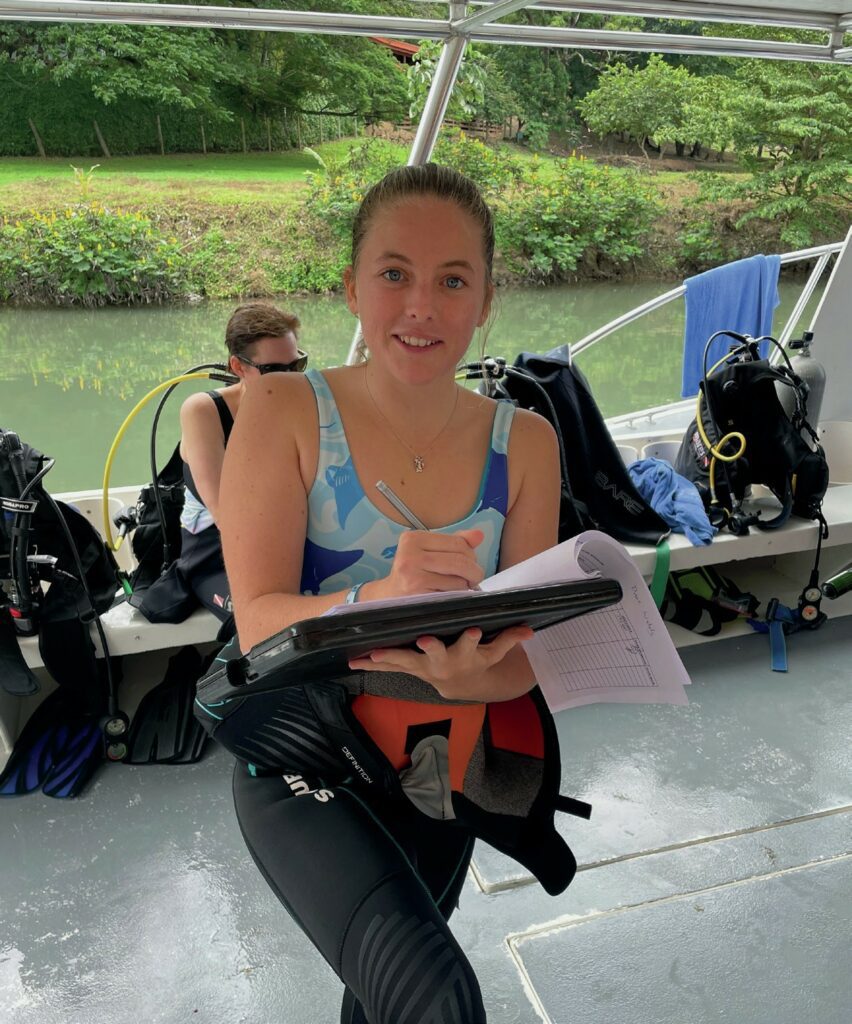
A (MW): I am not as lucky to have been to the Galapagos like Holly. But the first diving with a whaleshark in the Red Sea has to be right up there. We were diving a dive site called Fiddle Garden and within ten minutes of the dive, the Divemaster signals ‘shark’. I remember thinking this will be another reef shark or oceanic whiteteip, not expecting to turn around and see a bus-sized fish right next to me. I was in awe of this 39-foot fully grown whaleshark. This dive always sticks with me as your first whaleshark is unforgettable.
A (HW): Waiting at 16ft for three minutes can often be the most boring part of dive, especially if there is nothing to see. This particular dive in the Galapagos, the safety stop very quickly became the best part of the dive, the day and the whole trip. Over the three minutes we had an enormous pregnant whaleshark cruise by for a viewing of the little tiny divers in the water, we had a pod of dolphins not just swimming by us but interacting with us, playing with our bubbles and doing tricks in the water. Behind the dolphins was one of the Galapagos’ famous schools of hammerhead sharks, which were on almost every dive but never got boring, and to finish off the three minutes, we had a curious Galapagos shark hanging around.
I was actually upset to hear my computer beep at end of the safety stop, knowing I had to go up and get back on the boat. From this day forward, anytime anyone asks me about the Galapagos, this is the story I tell first, some people say if I didn’t get it on video then it didn’t happen, which makes it so much better that I got each and every one of these interactions on video and can look back on them whenever I please.
On the flipside, what is your worst diving memory?
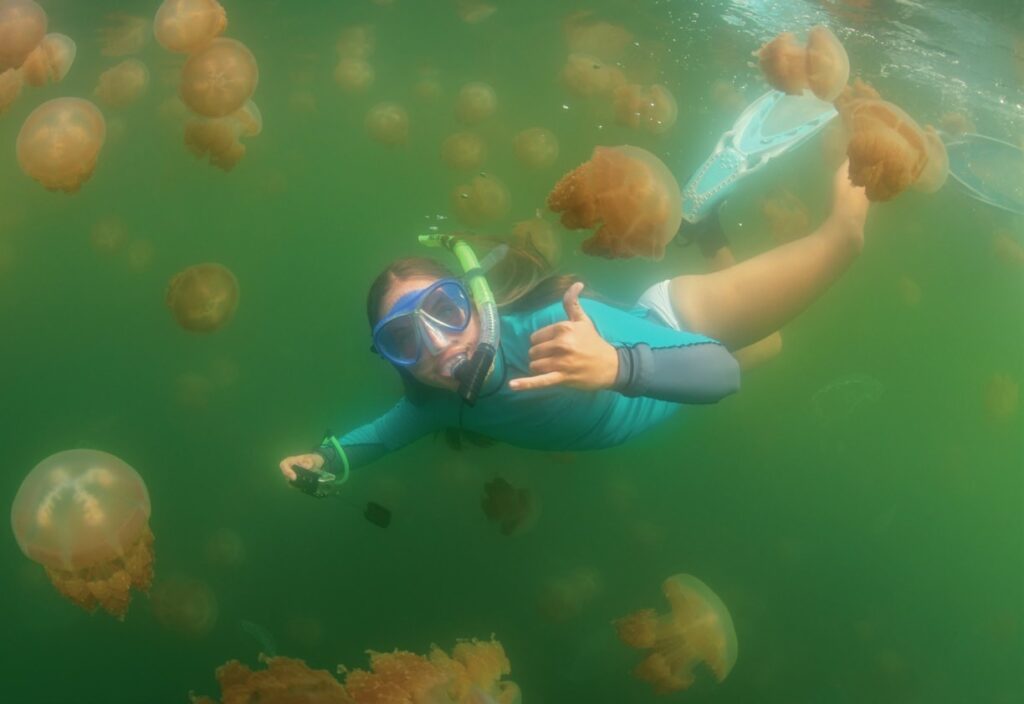
A (MW): My worst diving memory has always stayed with me since it happened in May 2009. During a staff dive trip to the Falls of Lora in Oban, Scotland, a simple mistake resulted in a very interesting dive. The Falls of Lora is meant to be dived at slack water, which still provides a nice drift dive. Unfortunately, the organizer of the trip read the tide tables wrong. We dived the Falls at incoming high tide, resulting in a wicked drift dive with down currents. I remember seeing the kelp bent fully over at the shoreline under the bridge, thinking this seems a bit quick.
When we dropped under the surface, I was ripped down to 72ft in seconds, bursting my left eardrum and perforating my right. The pressure squeeze on my drysuit made my back look like I had been whipped a thousand times – the drysuit squeeze had burst multiple blood capillaries in my back.
I was holding onto a rock in 7mm Waterproof mitts with two divers on my other hand. Both slipped off as the water pounded my mask and regulators, fighting to keep them both on me. I slipped further down the rock, ripping through my 7mm gloves and off the rock to depth. In this moment I thought ‘this really could be it’. I fully inflated my BCD to try to ascend (I know you shouldn’t) but still kept going down into the darkness.
I then fully inflated my drysuit but was still going down. I was ready to drop my weights when I got caught in an upwards current like a washing machine. I dumped all my air in my BCD and drysuit as fast as I could, controlling my ascent. I managed to get in an eddy between two rocks. Composing myself, checking my air and current situation. I started to make my ascent slowly, wondering where my dive buddies were and did an extended safety stop. I came up to carnage of every diver having been separated – everyone in the group was a dive pro being PADI, BSAC and SSI instructors.
Everyone made it out safely, thankfully and it was a huge learning curve. After six weeks I was given the all clear to dive again once my ears healed, just in time for my trip to Egypt. These are the dives I find make you a better diver as you clearly made the correct decisions in a difficult situation or learn what decisions would be better next time if the unexpected happens again.
A (HW): Though the majority of my diving memories are very cool and happy, there are a few which stand out among the crowd as not being great. At all. One of these was right after a dive with marine iguanas; we were in the area and there were not many more dive sites to explore. We had the option to either do another marine iguana dive or to go on a search for mola molas, and it was a unanimous decision to go and find mola molas.
After backrolling in and descending down, I started to get a bit confused. The water we had jumped into was a deep dark green, one that you weren’t even able to see your dive buddy through. At about 16ft, it was pitch black and we all turned our lights on. While descending we went at a 45-degree angle down, that aspect mixed with the total darkness made both my dive buddy and myself firmly believe we were in a cave. The next five minutes we didn’t do much, hooked into a rock with an absolutely ripping current and waited for a mola mola.
Apparently the group saw one, though with the number of bubbles around me at the time, I did not see anything. Everything was really hectic, with people all over the place and noise everywhere. We got the sound signal from our Divemaster to unhook and start our ascent. The current increased on the way up and we were briefed that if this happened we should grab a rock (not a coral!) on the wall and wait for further instruction.
My brother had a camera in one hand and a reef hook in the other hand, and instinctively let go of his camera to grab an area of the wall. Once he noticed, he went to reach for the camera and grabbed my mask off my face in the process, which ended somewhere in the water column and not on my face. Now with no mask, a ripping current and blurry vision, I made my way, with my buddy towards the surface, getting separated from the rest of the group.
Everything remained safe it wasn’t all that bad, just a bit hectic but when the Divemaster asked if we wanted to go and look for mola molas again, we all decided the marine iguanas would be the best way to end the day.
What does the future hold for Blue Horizon Diving?
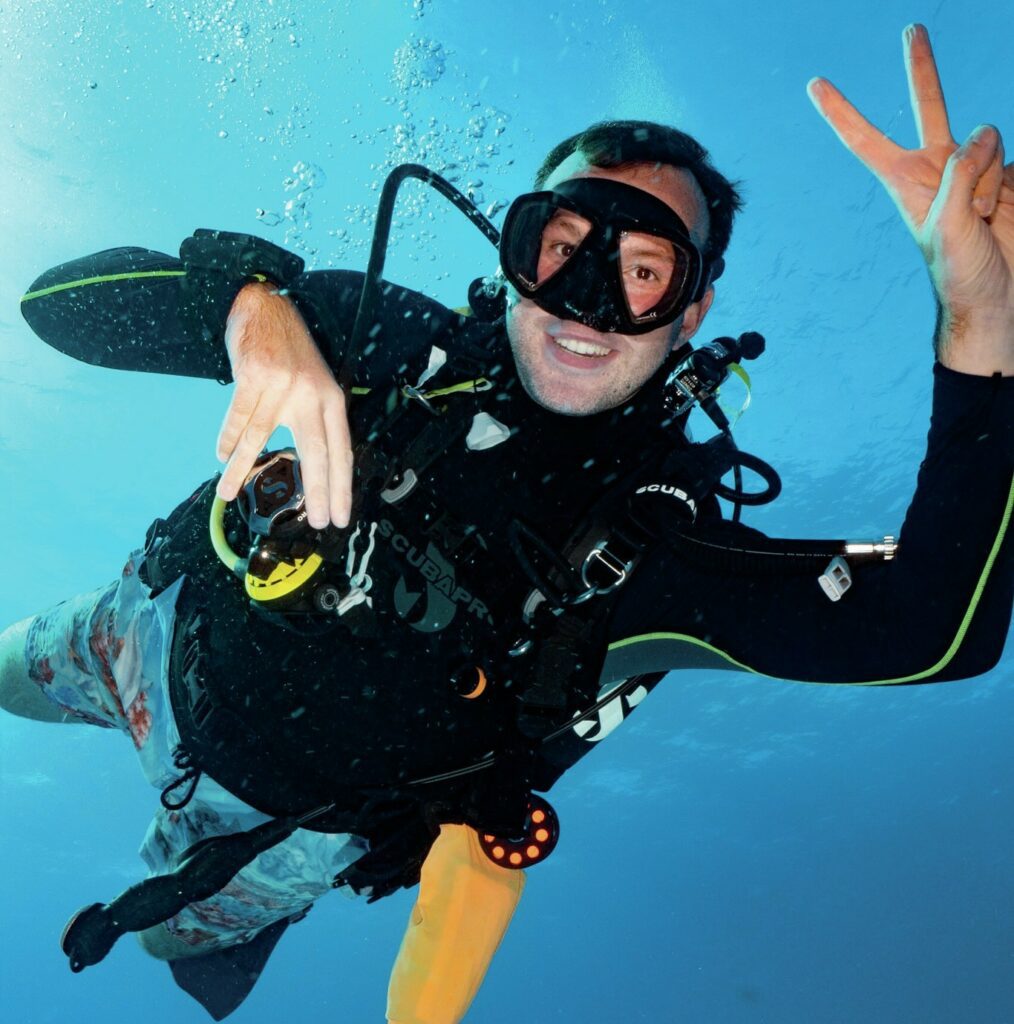
A (MW): 2023 is going to be a big year for Blue Horizon Diving. We are currently based in Australia, and this year we are starting to organise dive trips, so we are looking forward to diving around the world with subscribers to our YouTube Channel!
A (HW): I don’t have much to add on that expect for a personal aspect. I know we’re both very excited to do lots of travel this year and hope you will all come along for the crazy journey with us.
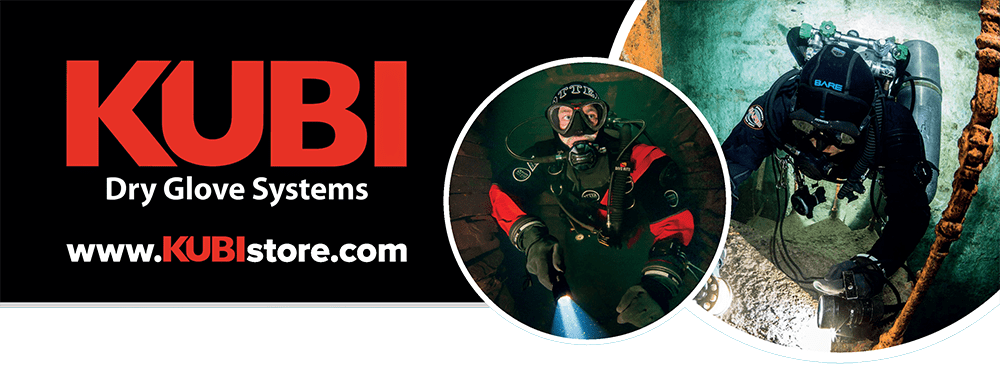
This article was originally published in Scuba Diver North America #13.
Subscribe digitally and read more great stories like this from anywhere in the world in a mobile-friendly format. Link to the article
